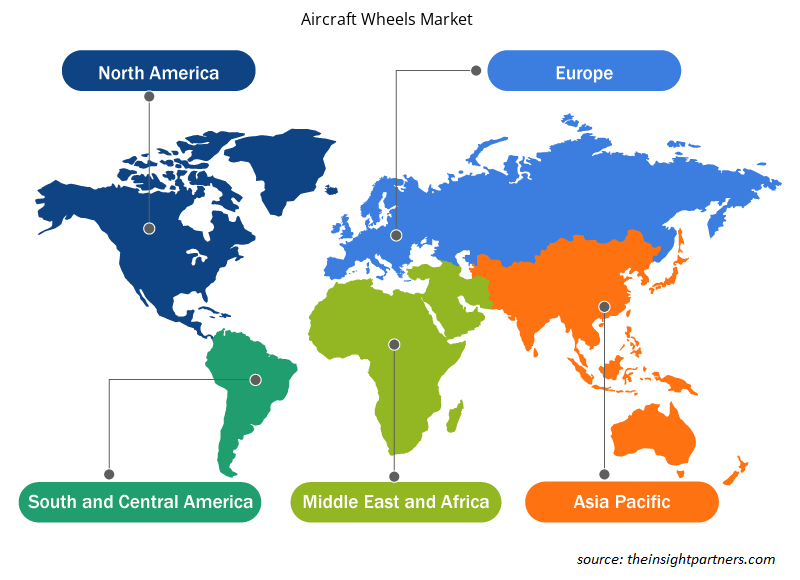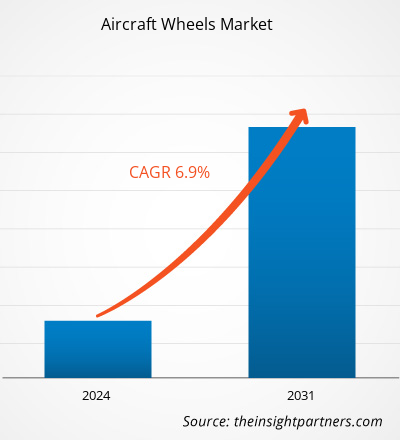预计到 2031 年,飞机机轮市场规模将从 2023 年的 18.3 亿美元增至 31.2 亿美元。预计 2023-2031 年期间,市场复合年增长率将达到 6.9%。预计在飞机前轮制造中增加使用 CFRP 复合材料仍将是市场的主要趋势。
飞机机轮市场分析
由于碳纤维增强复合材料的引入,飞机轮毂制造商广泛使用该材料来设计和制造飞机前轮。该材料以其高刚度和强度而闻名,这使得它与飞机前轮兼容。此外,复合材料的重量比铝和镁合金轻。因此,基于碳纤维增强塑料 (CFRP) 的轮毂有望降低飞机的质量密度。这将导致燃料消耗降低,飞机可以经济地运行。此外,航程或有效载荷可以增加。目前,飞机轮毂制造商正在开发由 CFRP 复合材料制成的飞机轮毂。例如,Fraunhofer LBF 正在使用 CFRP 复合材料为空客 A320 飞机开发前轮。因此,在未来几年,飞机轮毂制造商预计将越来越多地使用 CFRP 材料来制造飞机前轮。因此,预计飞机轮毂制造商使用 CFRP 复合材料制造飞机前轮的人数将会增加,并成为未来的趋势。
飞机机轮市场概况
飞机机轮市场生态系统由以下利益相关者组成:原材料和零部件供应商、飞机机轮制造商、飞机制造商和最终用户。飞机机轮制造商采购原材料和零部件,如钢、铝和镁合金,并从原材料和零部件供应商处采购螺母和螺栓等零部件。飞机机轮制造商将原材料和零部件组装成成品。这些制造商是飞机机轮市场的主要市场参与者,并占有相当大的市场份额。在市场上运营的知名参与者包括霍尼韦尔国际公司、赛峰集团、派克汉尼汾公司、雷神技术公司和 Matco Manufacturing Inc. 等。此外,这些制造商还向空客、波音、达索航空、庞巴迪、洛克希德马丁公司等飞机制造商供应飞机机轮,用于机轮的装配。此外,飞机机轮制造商还将机轮出售给汉莎技术公司、AAR 公司和 TP Aerospace 等机轮改装供应商。这些改装供应商为航空公司采购飞机机轮,并在飞机维护、修理和大修 (MRO) 服务期间进行机轮改装。
定制此报告以满足您的需求
您可以免费定制任何报告,包括本报告的部分内容、国家级分析、Excel 数据包,以及为初创企业和大学提供优惠和折扣
- 获取此报告的关键市场趋势。这个免费样品将包括数据分析,从市场趋势到估计和预测。
飞机机轮市场驱动因素和机遇
轻质合金在飞机轮毂制造中的应用日益广泛
传统的飞机机轮由镁合金制成。然而,在现代,制造商越来越多地探索轻质材料来制造飞机机轮,以实现高耐用性和低维护性。此外,由轻质合金制成的飞机机轮有助于飞机制造商通过减轻部分飞机重量来实现最佳燃油效率水平。因此,随着飞机机轮新技术的发展,制造商广泛使用各种类型的铝合金来使机轮重量更轻,耐腐蚀性更好。例如,UTC Aerospace Systems (UTAS) 正在探索一种银基铝合金来开发飞机机轮。银基铝制成的新机轮的强度预计将提高约 20%。此外,由于其刚度和耐腐蚀性提高,预计新型银基铝合金的损伤容限将提高约 70%。银基铝变体也可能使飞机机轮更轻,并减少维护停机时间。因此,越来越多地采用轻质合金制造飞机机轮推动了飞机机轮市场的增长。
碳纤维增强塑料轮子在旋翼飞机中的应用日益增多
目前,大多数直升机轮子都是由铝或镁等金属轻合金材料制成的。然而,碳纤维增强塑料 (CFRP) 制成的轮子比铝合金或镁合金轮子轻约 30%–40%。CFRP 轮子有望提供更好的耐腐蚀性和噪音、振动和声振粗糙度 (NVH) 性能。此外,这些轮子刚度更高,疲劳寿命更长,这将延长其使用寿命。制造商已经开始为旋翼飞机设计基于 CFRP 的轮子。例如,2021 年 1 月,总部位于英国的飞机轮子制造公司 Carbon ThreeSixty 开始为旋翼飞机开发基于 CFRP 的轮子。该公司预计将在未来 18 个月内完成轮子设计。这些复合材料轮子还可以与现有轮子互换,使其适合改装应用。因此,随着旋翼飞机中碳纤维增强塑料轮子的引入,预计未来几年市场将进一步蓬勃发展,并有机会渗透到旋翼飞机轮子领域。
飞机机轮市场报告细分分析
有助于得出飞机机轮市场分析的关键部分是类型、飞机类型、适合类型和最终用户。
- 根据类型,飞机轮子市场分为主轮和前轮。主轮部分在 2023 年占据了更大的市场份额。
- 根据飞机类型,飞机机轮市场分为固定翼飞机、旋翼飞机和无人机。固定翼飞机部分在 2023 年占据了更大的市场份额。UAV. The fixed wing aircraft segment held a larger market share in 2023.
- 根据装配类型,飞机机轮市场分为线装和改装。线装部分在 2023 年占据了更大的市场份额。
- 根据最终用户,飞机机轮市场分为商用和军用。商用领域在 2023 年占据了更大的市场份额。
飞机轮毂市场份额按地区分析
飞机机轮市场报告的地理范围主要分为五个地区:北美、欧洲、亚太、中东和非洲、南美。
2023 年,北美占据了市场主导地位,其次是亚太地区和欧洲地区。此外,亚太地区在未来几年的复合年增长率可能最高。此外,亚太地区在未来几年可能会超过北美飞机机轮市场。2023 年,中国在亚太飞机机轮市场中占有最大市场份额;而印度在未来几年的复合年增长率可能最高。航空业的快速增长和对客运航空服务的需求增加推动了该国的商业航空服务。因此,印度航空航天领域在建立 MRO 设施方面具有巨大的潜力和巨大的机会来建立合资企业和合作。因此,印度对飞机制造的重点关注和不断增长的商业航空服务预计将在未来几年推动全国飞机机轮市场的增长。
飞机机轮市场区域洞察
Insight Partners 的分析师已详细解释了预测期内影响飞机轮毂市场的区域趋势和因素。本节还讨论了北美、欧洲、亚太地区、中东和非洲以及南美和中美洲的飞机轮毂市场细分和地理位置。

- 获取飞机机轮市场的区域特定数据
飞机机轮市场报告范围
| 报告属性 | 细节 |
|---|---|
| 2023 年的市场规模 | 18.3亿美元 |
| 2031 年市场规模 | 31.2亿美元 |
| 全球复合年增长率(2023 - 2031) | 6.9% |
| 史料 | 2021-2022 |
| 预测期 | 2024-2031 |
| 涵盖的领域 | 按类型
|
| 覆盖地区和国家 | 北美
|
| 市场领导者和主要公司简介 |
|
飞机机轮市场参与者密度:了解其对业务动态的影响
飞机轮毂市场正在快速增长,这得益于终端用户需求的不断增长,而这些需求又源于消费者偏好的不断变化、技术进步以及对产品优势的认识不断提高等因素。随着需求的增加,企业正在扩大其产品范围,进行创新以满足消费者的需求,并利用新兴趋势,从而进一步推动市场增长。
市场参与者密度是指在特定市场或行业内运营的企业或公司的分布情况。它表明在给定市场空间中,相对于其规模或总市场价值,有多少竞争对手(市场参与者)存在。
在飞机机轮市场运营的主要公司有:
- 雷神技术公司
- 霍尼韦尔国际公司
- 派克汉尼汾公司
- 赛峰集团
- 贝灵哲航空美国公司
- 汉莎技术公司
免责声明:上面列出的公司没有按照任何特定顺序排列。

- 获取飞机轮子市场顶级关键参与者概述
飞机机轮市场新闻和最新发展
飞机机轮市场通过收集一手和二手研究后的定性和定量数据进行评估,其中包括重要的公司出版物、协会数据和数据库。下面列出了飞机机轮市场的一些发展情况:
- 赛峰起落架系统公司在其位于法国韦利济-维拉库布莱的工厂内启用了一座经过全面改造的实验室,该实验室专门用于测试其机轮和碳刹车,并配备了新的测试台。该公司将投资总计 1000 万欧元来实施这一雄心勃勃的项目。(来源:赛峰,新闻稿,2024 年 4 月)
- 全球领先的飞机部件测试和支持设备制造商 Bauer 宣布成立机轮和刹车设备业务部门。(来源:Bauer Inc,新闻稿,2024 年 4 月)
飞机机轮市场报告覆盖范围和交付成果
“飞机机轮市场规模和预测(2021-2031)”报告对以下领域进行了详细的市场分析:
- 范围内涵盖的所有主要细分市场的全球、区域和国家层面的飞机机轮市场规模和预测
- 飞机机轮市场趋势以及市场动态,如驱动因素、限制因素和关键机遇
- 详细的PEST分析
- 飞机机轮市场分析涵盖主要市场趋势、全球和区域框架、主要参与者、法规和最新市场发展
- 行业格局和竞争分析,涵盖市场集中度、热图分析、知名参与者以及飞机机轮市场的最新发展
- 详细的公司简介
- 历史分析(2 年)、基准年、预测(7 年)及复合年增长率
- PEST 和 SWOT 分析
- 市场规模价值/数量 - 全球、区域、国家
- 行业和竞争格局
- Excel 数据集


- Social Employee Recognition System Market
- Influenza Vaccines Market
- GMP Cytokines Market
- Small Molecule Drug Discovery Market
- Precast Concrete Market
- EMC Testing Market
- Terahertz Technology Market
- Vision Guided Robotics Software Market
- Customer Care BPO Market
- Pressure Vessel Composite Materials Market

Report Coverage
Revenue forecast, Company Analysis, Industry landscape, Growth factors, and Trends

Segment Covered
This text is related
to segments covered.

Regional Scope
North America, Europe, Asia Pacific, Middle East & Africa, South & Central America

Country Scope
This text is related
to country scope.
常见问题
North America region dominated the aircraft wheels market in 2023.
The rising volumes of aircraft deliveries and the growing adoption of lightweight alloy to manufacture aircraft wheels are some of the factors driving the growth for aircraft wheels market.
Increasing use of CFRP composite in aircraft nose wheel manufacturing is one of the major trends of the market.
Raytheon Technologies Corporation, Honeywell International Inc, Parker Hannifin Corporation, Safran Group, Beringer Aero Usa, Lufthansa Technik, Tae Aerospace, Bauer Inc, and Matco Manufacturing Inc are some of the key players profiled under the report.
The estimated value of the aircraft wheels market by 2031 would be around US$ 3.12 billion.
The aircraft wheels market is likely to register of 6.9% during 2023-2031.
Trends and growth analysis reports related to Aerospace and Defense : READ MORE..
The Insight Partners performs research in 4 major stages: Data Collection & Secondary Research, Primary Research, Data Analysis and Data Triangulation & Final Review.
- Data Collection and Secondary Research:
As a market research and consulting firm operating from a decade, we have published and advised several client across the globe. First step for any study will start with an assessment of currently available data and insights from existing reports. Further, historical and current market information is collected from Investor Presentations, Annual Reports, SEC Filings, etc., and other information related to company’s performance and market positioning are gathered from Paid Databases (Factiva, Hoovers, and Reuters) and various other publications available in public domain.
Several associations trade associates, technical forums, institutes, societies and organization are accessed to gain technical as well as market related insights through their publications such as research papers, blogs and press releases related to the studies are referred to get cues about the market. Further, white papers, journals, magazines, and other news articles published in last 3 years are scrutinized and analyzed to understand the current market trends.
- Primary Research:
The primarily interview analysis comprise of data obtained from industry participants interview and answers to survey questions gathered by in-house primary team.
For primary research, interviews are conducted with industry experts/CEOs/Marketing Managers/VPs/Subject Matter Experts from both demand and supply side to get a 360-degree view of the market. The primary team conducts several interviews based on the complexity of the markets to understand the various market trends and dynamics which makes research more credible and precise.
A typical research interview fulfils the following functions:
- Provides first-hand information on the market size, market trends, growth trends, competitive landscape, and outlook
- Validates and strengthens in-house secondary research findings
- Develops the analysis team’s expertise and market understanding
Primary research involves email interactions and telephone interviews for each market, category, segment, and sub-segment across geographies. The participants who typically take part in such a process include, but are not limited to:
- Industry participants: VPs, business development managers, market intelligence managers and national sales managers
- Outside experts: Valuation experts, research analysts and key opinion leaders specializing in the electronics and semiconductor industry.
Below is the breakup of our primary respondents by company, designation, and region:

Once we receive the confirmation from primary research sources or primary respondents, we finalize the base year market estimation and forecast the data as per the macroeconomic and microeconomic factors assessed during data collection.
- Data Analysis:
Once data is validated through both secondary as well as primary respondents, we finalize the market estimations by hypothesis formulation and factor analysis at regional and country level.
- Macro-Economic Factor Analysis:
We analyse macroeconomic indicators such the gross domestic product (GDP), increase in the demand for goods and services across industries, technological advancement, regional economic growth, governmental policies, the influence of COVID-19, PEST analysis, and other aspects. This analysis aids in setting benchmarks for various nations/regions and approximating market splits. Additionally, the general trend of the aforementioned components aid in determining the market's development possibilities.
- Country Level Data:
Various factors that are especially aligned to the country are taken into account to determine the market size for a certain area and country, including the presence of vendors, such as headquarters and offices, the country's GDP, demand patterns, and industry growth. To comprehend the market dynamics for the nation, a number of growth variables, inhibitors, application areas, and current market trends are researched. The aforementioned elements aid in determining the country's overall market's growth potential.
- Company Profile:
The “Table of Contents” is formulated by listing and analyzing more than 25 - 30 companies operating in the market ecosystem across geographies. However, we profile only 10 companies as a standard practice in our syndicate reports. These 10 companies comprise leading, emerging, and regional players. Nonetheless, our analysis is not restricted to the 10 listed companies, we also analyze other companies present in the market to develop a holistic view and understand the prevailing trends. The “Company Profiles” section in the report covers key facts, business description, products & services, financial information, SWOT analysis, and key developments. The financial information presented is extracted from the annual reports and official documents of the publicly listed companies. Upon collecting the information for the sections of respective companies, we verify them via various primary sources and then compile the data in respective company profiles. The company level information helps us in deriving the base number as well as in forecasting the market size.
- Developing Base Number:
Aggregation of sales statistics (2020-2022) and macro-economic factor, and other secondary and primary research insights are utilized to arrive at base number and related market shares for 2022. The data gaps are identified in this step and relevant market data is analyzed, collected from paid primary interviews or databases. On finalizing the base year market size, forecasts are developed on the basis of macro-economic, industry and market growth factors and company level analysis.
- Data Triangulation and Final Review:
The market findings and base year market size calculations are validated from supply as well as demand side. Demand side validations are based on macro-economic factor analysis and benchmarks for respective regions and countries. In case of supply side validations, revenues of major companies are estimated (in case not available) based on industry benchmark, approximate number of employees, product portfolio, and primary interviews revenues are gathered. Further revenue from target product/service segment is assessed to avoid overshooting of market statistics. In case of heavy deviations between supply and demand side values, all thes steps are repeated to achieve synchronization.
We follow an iterative model, wherein we share our research findings with Subject Matter Experts (SME’s) and Key Opinion Leaders (KOLs) until consensus view of the market is not formulated – this model negates any drastic deviation in the opinions of experts. Only validated and universally acceptable research findings are quoted in our reports.
We have important check points that we use to validate our research findings – which we call – data triangulation, where we validate the information, we generate from secondary sources with primary interviews and then we re-validate with our internal data bases and Subject matter experts. This comprehensive model enables us to deliver high quality, reliable data in shortest possible time.


 获取此报告的免费样本
获取此报告的免费样本